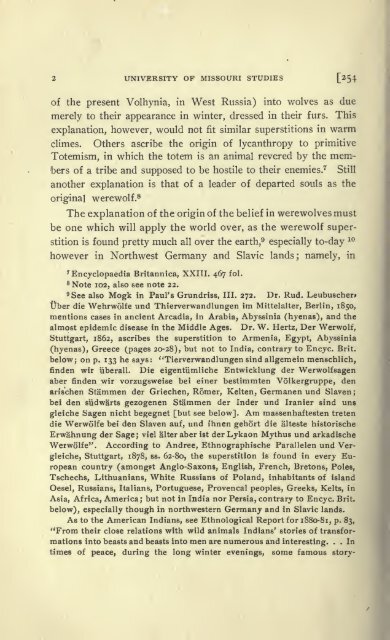origin of were wolf
Create successful ePaper yourself
Turn your PDF publications into a flip-book with our unique Google optimized e-Paper software.
2 UNIVERSITY OF MISSOURI STUDIES [254<br />
<strong>of</strong> the present Volhynia, in West Russia) into wolves as due<br />
dressed in their furs. This<br />
merely to their appearance in winter,<br />
explanation, however, would not fit similar superstitions in warm<br />
climes. Others ascribe the <strong>origin</strong> <strong>of</strong> lycanthropy to primitive<br />
Totemism, in which the totem is an animal revered by the mem-<br />
'bers <strong>of</strong> a tribe and supposed to be hostile to their enemies. 7 Still<br />
another explanation<br />
is that <strong>of</strong> a leader <strong>of</strong> departed<br />
souls as the<br />
<strong>origin</strong>al <strong>were</strong><strong>wolf</strong>. 8<br />
The explanation <strong>of</strong> the <strong>origin</strong> <strong>of</strong> the belief in <strong>were</strong>wolves must<br />
be one which will apply the world over, as the <strong>were</strong><strong>wolf</strong> superstition<br />
is found pretty much all over the earth,<br />
9 especially to-day<br />
10<br />
however in Northwest Germany and Slavic lands; namely, in<br />
7<br />
Encyclopaedia Britannica, XXITI. 467 fol.<br />
8<br />
Note 102, also see note 22.<br />
9<br />
See also Mogk in Paul's Grundriss, III. 272. Dr. Rud. Leubuscher*<br />
ftber die Wehr<strong>wolf</strong>e und Thierverwandlungen im Mittel alter, Berlin, 1850,<br />
mentions cases in ancient Arcadia, in Arabia, Abyssinia (hyenas), and the<br />
almost epidemic disease in the Middle Ages. Dr. W. Hertz, Der Wer<strong>wolf</strong>,<br />
Stuttgart, 1862, ascribes the superstition to Armenia, Egypt, Abyssinia<br />
(hyenas), Greece (pages 20-28), but not to India, contrary to Encyc. Brit,<br />
below; on p. 133 he says: "Tierverwandlungen sind allgemein menschlich,<br />
finden wir iiberall. Die eigentiimliche Entwicklung der Wer<strong>wolf</strong>sagen<br />
aber finden wir vorzugsweise bei einer bestimmten Volkergruppe, den<br />
arischen Stammen der Griechen, Romer, Kelten, Germanen und Slaven;<br />
bei den siidwarts gezogenen Stammen der Inder und Iranier sind uns<br />
gleiche Sagen nicht begegnet [but see below]. Am massenhaftesten treten<br />
die Wer<strong>wolf</strong>e bei den Slaven auf, und ihnen gehort die alteste historische<br />
Erwahnung der Sage; viel alter aber ist der Lykaon Mythus und arkadische<br />
Wer<strong>wolf</strong>e". According to Andree, Ethnographische Parallelen und Vergleiche,<br />
Stuttgart, 1878, ss. 62-80, the superstition is found in every European<br />
country (amongst Anglo-Saxons, English, French, Bretons, Poles,<br />
Tschechs, Lithuanians, White Russians <strong>of</strong> Poland, inhabitants <strong>of</strong> island<br />
Oesel, Russians, Italians, Portuguese, Provencal peoples, Greeks, Kelts, in<br />
Asia, Africa, America; but not in India nor Persia, contrary to Encyc. Brit,<br />
below), especially though in northwestern Germany and in Slavic lands.<br />
As to the American Indians, see Ethnological Report for 1880-81, p. 83,<br />
"From their close relations with wild animals Indians' stories <strong>of</strong> transformations<br />
into beasts and beasts into men are numerous and interesting.<br />
. . In<br />
times <strong>of</strong> peace, during the long winter evenings, some famous story-


